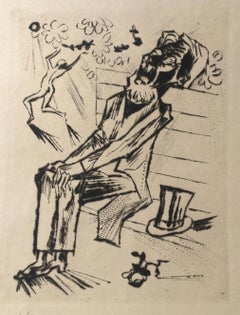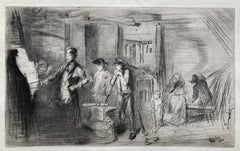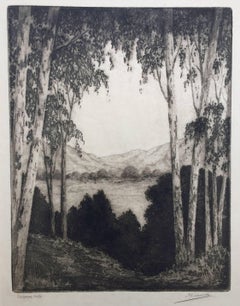Want more images or videos?
Request additional images or videos from the seller
1 of 4
Julian Alden WeirHEAD OF A WOMAN IN PROFILE1891
1891
$800List Price
About the Item
- Creator:Julian Alden Weir (1852-1919, American)
- Creation Year:1891
- Dimensions:Height: 7.875 in (20.01 cm)Width: 5.875 in (14.93 cm)
- Medium:
- Movement & Style:
- Period:
- Condition:See description. Some toning of sheet, some soiling, other minor flaws. Otherwise good.
- Gallery Location:Santa Monica, CA
- Reference Number:1stDibs: LU41132475281
About the Seller
5.0
Recognized Seller
These prestigious sellers are industry leaders and represent the highest echelon for item quality and design.
Gold Seller
Premium sellers maintaining a 4.3+ rating and 24-hour response times
Established in 1977
1stDibs seller since 2016
293 sales on 1stDibs
Typical response time: 1 hour
Associations
International Fine Print Dealers Association
Authenticity Guarantee
In the unlikely event there’s an issue with an item’s authenticity, contact us within 1 year for a full refund. DetailsMoney-Back Guarantee
If your item is not as described, is damaged in transit, or does not arrive, contact us within 7 days for a full refund. Details24-Hour Cancellation
You have a 24-hour grace period in which to reconsider your purchase, with no questions asked.Vetted Professional Sellers
Our world-class sellers must adhere to strict standards for service and quality, maintaining the integrity of our listings.Price-Match Guarantee
If you find that a seller listed the same item for a lower price elsewhere, we’ll match it.Trusted Global Delivery
Our best-in-class carrier network provides specialized shipping options worldwide, including custom delivery.You May Also Like
Darius at 10
By Darius Steward
Located in Fairlawn, OH
Darius at 10
Drypoint, 2022
Signed, titled and numbered in pencil
Printed by Rebekah Wilhelm
Her drystamp lower right
Published by the artist
Edition 14, plus proofs
Condition: Excel...
Category
2010s American Realist Figurative Prints
Materials
Drypoint
Indian Friendship Dance
By Gene Kloss
Located in Fairlawn, OH
Indian Friendship Dance
Drypoint, 1953
Signed in pencil lower right, (see photo)
Edition 200
Published by The Society of American Graphic Artists, New York
An impression is in the collection of SAAM, Washington and RISD Museum,
Condition: Excellent
Very rich impression with burr and selective whiping of the ink for atmospheric nocturnal effect.
Image/Plate size: 8 3/16 x 11 15/16 inches
Sheet size: 11 1/8 x 17 inches
Reference: Kloss 450
"'Indian Friendship Dance' is an eloquent statement of something which Gene Kloss has both observed and participated in. It is an Indian dance that is thought of as entertainment, rather than ceremony, but it is essentially an idea expressed in action, and an idea that has universal meaning. The young men who dance wear costumes of exquisite workmanship, intricately wrought with beads and feathers and subtle combinations of colors. The dancers are trained from childhood but develop their own steps and exhibit distinctive strength and grace. Singers and a tom-tom accompany the dance and since it usually takes place at night, a campfire is the source of light. The conclusion occurs when all the onlookers, old and young and from many places, join hands with the dancers in a slow revolving movement, while those who can, sing the difficult but meaningful Indian song that flows with the rhythmical dance step and speaks of fellowship, brotherhood, friendship." - An excerpt from a descriptive statement, written by Lynd Ward, and distributed with the drypoint at the time of publication." Courtesy Old Print Shop
Born Alice Glasier in Oakland, CA, Kloss grew up amid the worldly bustle of the San Francisco Bay Area. She attended the University of California at Berkeley, graduating with honors in art in 1924. She discovered her talents in intaglio printmaking during a senior-year course in figurative drawing. The professor, Perham Nahl, held up a print from Kloss’ first plate, still damp from the printing process, and announced that she was destined to become a printmaker.
In 1925, Gene married Phillips Kloss, a poet and composer who became her creative partner for life. The match was uncanny, for in her own way Gene, too, was a poet and a composer. Like poetry, her artworks capture a moment in time; like music, her compositions sing with aesthetic harmony. Although she was largely self-taught, Kloss was a printmaking virtuoso.
On their honeymoon the Klosses traveled east from California, camping along the way. They spent two week is Taos Canyon – with a portable printing press cemented to a rock near their campsite – where Gene learned to appreciate the wealth of artistic subject matter in New Mexico. The landscape, the cultures, and the immense sky left an indelible impression on the couple, who returned every summer until they made Taos their permanent home 20 years later.
Throughout her life, Kloss etched more than 625 copper plates, producing editions ranging from five to 250 prints. She pulled every print in every edition herself, manually cranking the wheel of her geared Sturges press until she finally purchased a motorized one when she was in her 70s. Believing that subject matter dictated technique, she employed etching, drypoint, aquatint, mezzotint, roulette, softground, and a variety of experimental approaches, often combining several techniques on the same plate. She also produced both oil and watercolor paintings.
Kloss’ artworks are filled with drama. Her prints employ striking contrasts of darkness and light, and her subjects are often illuminated by mysterious light sources. Though she was a devout realist, there is also a devout abstraction on Kloss’ work that adds an almost mythical quality.
For six decades Kloss documented the cultures of the region-from images of daily life to those of rarely seen ceremonies. She and her husband shared a profound respect for the land and people, which made them welcome among the Native American and Hispanic communities. Kloss never owned a camera but relied instead on observation and recollection. Her works provide an inside look at the cultures she depicted yet at the same time communicate the awe and freshness of an outsider’s perspective.
Although Kloss is best known for her images of Native American and Penitente scenes, she found artistic inspiration wherever she was. During the early years of their marriage, when she and Phil returned to the Bay Area each winter to care for their aging families, she created images of the California coast. And when the Klosses moved to southwestern Colorado in 1965, she etched the mining towns and mountainous landscapes around her.
In 1970 the Klosses returned to Taos and built a house north of town. Though her artwork continued to grow in popularity, she remained faithful to Taos’ Gallery A, where she insisted that owner Mary Sanchez keep the prices of her work reasonable regardless of its market value. Kloss continued to etch until 1985, when declining health made printmaking too difficult.
From her first exhibition at San Francisco’s exclusive Gump’s in 1937 to her 1972 election to full membership in the National Academy of Design, Kloss experienced a selective fame. She received numerous awards, and though she is not as well known as members of the Taos Society of Artists...
Category
1950s American Realist Figurative Prints
Materials
Drypoint
Keresan Dancers
By Gene Kloss
Located in Fairlawn, OH
Keresan Dancers
Etching & drypoint, 1962
Signed lower right (see photo)
Inscribed lower left: "Artist's Proof Keresan Dancers"
Depicts Keresan speaking peoples at Sam Felipe Pueblo
Contemporary Puebloans are customarily described as belonging to either the eastern or the western division. The eastern Pueblo villages are in New Mexico along the Rio Grande and comprise groups who speak Tanoan and Keresan languages. Tanoan languages such as Tewa are distantly related to Uto-Aztecan, but Keresan has no known affinities. The western Pueblo villages include the Hopi villages of northern Arizona and the Zuni, Acoma, and Laguna villages, all in western New Mexico.
Born Alice Glasier in Oakland, CA, Kloss grew up amid the worldly bustle of the San Francisco Bay Area. She attended the University of California at Berkeley, graduating with honors in art in 1924. She discovered her talents in intaglio printmaking during a senior-year course in figurative drawing. The professor, Perham Nahl, held up a print from Kloss’ first plate, still damp from the printing process, and announced that she was destined to become a printmaker.
In 1925, Gene married Phillips Kloss, a poet and composer who became her creative partner for life. The match was uncanny, for in her own way Gene, too, was a poet and a composer. Like poetry, her artworks capture a moment in time; like music, her compositions sing with aesthetic harmony. Although she was largely self-taught, Kloss was a printmaking virtuoso.
On their honeymoon the Klosses traveled east from California, camping along the way. They spent two week is Taos Canyon – with a portable printing press cemented to a rock near their campsite – where Gene learned to appreciate the wealth of artistic subject matter in New Mexico. The landscape, the cultures, and the immense sky left an indelible impression on the couple, who returned every summer until they made Taos their permanent home 20 years later.
Throughout her life, Kloss etched more than 625 copper plates, producing editions ranging from five to 250 prints. She pulled every print in every edition herself, manually cranking the wheel of her geared Sturges press until she finally purchased a motorized one when she was in her 70s. Believing that subject matter dictated technique, she employed etching, drypoint, aquatint, mezzotint, roulette, softground, and a variety of experimental approaches, often combining several techniques on the same plate. She also produced both oil and watercolor paintings.
Kloss’ artworks are filled with drama. Her prints employ striking contrasts of darkness and light, and her subjects are often illuminated by mysterious light sources. Though she was a devout realist, there is also a devout abstraction on Kloss’ work that adds an almost mythical quality.
For six decades Kloss documented the cultures of the region-from images of daily life to those of rarely seen ceremonies. She and her husband shared a profound respect for the land and people, which made them welcome among the Native American and Hispanic communities. Kloss never owned a camera but relied instead on observation and recollection. Her works provide an inside look at the cultures she depicted yet at the same time communicate the awe and freshness of an outsider’s perspective.
Although Kloss is best known for her images of Native American and Penitente scenes, she found artistic inspiration wherever she was. During the early years of their marriage, when she and Phil returned to the Bay Area each winter to care for their aging families, she created images of the California coast. And when the Klosses moved to southwestern Colorado in 1965, she etched the mining towns and mountainous landscapes around her.
In 1970 the Klosses returned to Taos and built a house north of town. Though her artwork continued to grow in popularity, she remained faithful to Taos’ Gallery A, where she insisted that owner Mary Sanchez keep the prices of her work reasonable regardless of its market value. Kloss continued to etch until 1985, when declining health made printmaking too difficult.
From her first exhibition at San Francisco’s exclusive Gump’s in 1937 to her 1972 election to full membership in the National Academy of Design, Kloss experienced a selective fame. She received numerous awards, and though she is not as well known as members of the Taos Society of Artists...
Category
1960s American Realist Figurative Prints
Materials
Drypoint
Man Holding Hat
By Isabel Bishop
Located in Middletown, NY
New York: Sylvan Cole, 1929.
Etching on white wove Rives paper with an infinity watermark, 5 15/16 x 3 15/16 inches (151 x 100 mm); sheet 15 7/16 x 11 15/16 inches (392 x 303 mm), f...
Category
1920s American Realist Portrait Prints
Materials
Drypoint, Aquatint
The Fish Market
Located in Middletown, NY
Etching with drypoint and aquatint on laid Japon paper, 9 x 11 1/4 inches (228 x 280 mm); sheet 11 7/8 x 13 5/8 (302 x 346 mm), full margins. Signed, titled and inscribed "To my dear...
Category
Mid-20th Century American Realist Portrait Prints
Materials
Aquatint, Drypoint
Sniggling for Eel
By Douglas Gorsline
Located in Middletown, NY
Etching with drypoint in black ink on antique laid paper with various large watermarks, 6 3/4 x 5 3/8 inches (172 x 132 mm), full margins with deckle edges on two sides. Signed, date...
Category
Mid-20th Century American Realist Portrait Prints
Materials
Laid Paper, Drypoint, Etching
Villefranche-sur-mer
By Louis Conrad Rosenberg
Located in Middletown, NY
Etching with drypoint in brownish black ink on cream wove paper, 6 1/8 x 10 inches (155 x 255 mm), full margins with a deckle edge. Signed in pencil, lower right margin, and titled (...
Category
Early 20th Century American Realist Landscape Prints
Materials
Drypoint, Etching
Fourteenth Street Oriental
By Isabel Bishop
Located in Middletown, NY
New York: Associated American Artists, 1950. Drypoint and aquatint on white wove paper, 5 7/8 x 3 15/16 inches (150 x 100 mm), full margins. Signed in pencil in the lower margin. Pri...
Category
Mid-20th Century American Realist Portrait Prints
Materials
Drypoint, Aquatint
Little Penthouse
By Martin Lewis
Located in New York, NY
Martin Lewis (1881-1962), Little Penthouse, drypoint, 1931, signed in pencil lower right [signed in the plate in a rectangle lower left]. Reference: McCarron 91, only state. Printed ...
Category
1930s American Realist Figurative Prints
Materials
Drypoint
At the Show
By Jerome Myers
Located in New York, NY
Jerome Myers (1867-1940), At the Show, etching and drypoint, c. 1920, signed in pencil lower right. In good condition, with margins (paper losses upper corners), faint ink marks and ...
Category
1920s American Realist Figurative Prints
Materials
Drypoint, Etching
More From This Seller
View AllDER SCHATTEN II - Rich Drypoint - 1st State
By Hermann Max Pechstein
Located in Santa Monica, CA
MAX PECHSTEIN (1881 -1955)
DER SCHATTEN II 1918 (Knupp 79, Fecher 143 I/ii)
Rich drypoint, signed and annotated, FIRST STATE. Image: 8 1/4 x 6 inches on japan paper; 15 x 11 1/4 i...
Category
1910s Expressionist Figurative Prints
Materials
Drypoint
Vachère au Bord de l'Eau
By Camille Pissarro
Located in Santa Monica, CA
CAMILLE PISSARRO (French 1830-1903)
VACHERE au BORD de l’EAU 1890 (Delteil 93 viii/viii)
Etching, unsigned as published in “Gazette des Beaux Arts”, Paris, 1890. On laid paper
Very...
Category
1890s Impressionist Figurative Prints
Materials
Drypoint, Etching
$1,463 Sale Price
24% Off
THE FORGE - Rich Drypoint
By James Abbott McNeill Whistler
Located in Santa Monica, CA
JAMES ABBOTT MCNEIL WHISTLER (1834 – 1903)
THE FORGE 1866 (Kennedy. 68 iv/vi: Glascow 86 vi/vi)
Etching and drypoint. Signed and dated in the plate 1866. VERY GOOD IMPRESSION WITH...
Category
Late 19th Century Impressionist Figurative Prints
Materials
Drypoint
CALIFORNIA VISTA
By Harold Lukens Doolittle
Located in Santa Monica, CA
HAROLD L. DOOLITTLE (1883 – 1974)
CALIFORNIA VISTA, 1923
Aquatint signed and titled in pencil. 8 7/8 x 6 7/8 inches. Sheet 11 x 14 inches. Good condi...
Category
1920s American Realist Figurative Prints
Materials
Aquatint
$780 Sale Price
20% Off
LAST MOMENTS OF PRESIDENT LINCOLN
Located in Santa Monica, CA
J. F. BUFFORD PUBLISHER and PRINTER
LAST MOMENTS OF PRESIDENT LINCOLN, April 15, 1865
Lithograph, very good impression. The 2 lower publishing lines ...
Category
1860s American Realist Figurative Prints
Materials
Lithograph
THANKSGIVING IN CAMP
By Winslow Homer
Located in Santa Monica, CA
AFTER - WINSLOW HOMER (1836-1910)
THANKSGIVING IN THE ARMY - After Dinner: the Wishbone, 1864
Original wood engraving as published by Harpers Weekly December 3, 1864, after a drawing by Winslow Homer. Image 9 3/4" x 14, Sheet 10 3.\/4 x 15 3/4" . Generally good condition, a small stain in the upper right margin.
Homer contributed drawings to Harper's Weekly from 1857 to 1875. They were converted to wood engravings by Harper's craftsman and published in Harper's Weekly. Although after his original drawings, they are now accepted as an important part of his body of work by museums and collectors. They were very large editions. As such, they occur often in the marketplace. Harper's published during the Civil War years as this was, were widely read and kept as people followed the war first hand and its aftermath over the years continuing today as both Homer and Civil War collectables
Category
1860s American Realist Figurative Prints
Materials
Woodcut
$175 Sale Price
53% Off
Recently Viewed
View AllMore Ways To Browse
Picasso Ecuyere
Picasso Farol
Picasso Lithograph Bathers
Picasso Lithograph Couple
Picasso Marlborough
Picasso Pencil Signed
Picasso Plates Signed
Picasso Series 156
Picasso Toros Vallauris
Picasso Woman With Hat
Pierre Etienne Moitte
Piranesi Prints Carceri
Pop Shop 1
Poster Mardi Gras
Raoul Dufy Horse Lithograph
Raoul Dufy Lithograph Ascot
Rare Album Covers
Renato Guttuso On Sale



